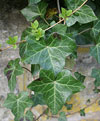
Researchers have now made the discovery that naturally occurring nanoparticles have unique optical properties. In addition, they are less toxic and biodegradable than their synthesized, metal-based counterparts. This discovery makes it likely that scientists will be able to find more biocompatible nanoparticles to replace metal-based nanoparticles, predominantly for biomedical applications.
"The concern for the biosafety and health risk for the metal-based and engineered nanoparticles in sunscreens has led to the search for alternative replacement nanoparticles," Mingjun Zhang, an Associate Professor of Biomedical Engineering at the University of Tennessee, tells Nanowerk. "In our recent study we investigated naturally occurring ivy nanoparticles to replace titanium dioxide and zinc oxide that are currently widely used in sunscreen products. Based on experimental data, we have demonstrated that ivy nanoparticles have the potential levels of UV protection, and a much lesser level of cell toxicity than metal nanoparticles, necessary to warrant further investigation for uses in cosmetics."
In a previous Nanowerk Spotlight, we have reported about Zhang's work on ivy plants and nanoparticles secreted from them (see: "Ivy's gripping nanotechnology secrete"). Now, in this new work, Zhang and his team explored the optical properties of the organic nanoparticles isolated from ivy. The researchers have reported their findings in a recent issue of Nanoscale Research Letters.
"Natural nanoparticles can be used as functional materials just as artificial nanoparticles" says Zhang. "Take for instance sunscreen. Here, organic and inorganic nanoparticles with with ultraviolet extinction properties are widely used. The inorganic nanoparticles – such as titanium dioxide and zinc oxide – and organic nanoparticles can reflect, absorb and scatter the solar light and thus provide the sunblock effect. However, although inorganic nanoparticles have been widely used in cosmetic products, there are still concerns about the toxicity of these inorganic materials."
According to the researchers, natural or biological nanoparticles have not been investigated in detail for their material properties. In this recent study, the University of Tennessee team investigates these type nanoparticles as the functional materials just like usual inorganic and organic nanoparticles.
Zhang notes that the ivy nanoparticles are not monodisperse in solutions. "This effect is due to the biological process of the nanoparticle formation" he says. "Nanoparticles from the original tiny ones to the mature ones all exit in the rootlets of ivy. We used size exclusion chromatography (SEC) and high-performance liquid chromatography (SEC-HPLC) to isolate the nanoparticles from the mixed solutions including molecules, but it did not give us uniform size of nanoparticles."
This means that one area of future investigation needs to explore effective methods to obtain monodisperse ivy nanoparticles. The modifications of ivy nanoparticles to improve the optical properties are also expected. Zhang says that the team will also explore potential coatings for solar panels.
This makes it likely that if nature-derived harmless organic nanoparticles have strong ultraviolet absorption, they will be a potential promising alternative for sunscreen.Quite impressively, the team's study indicates that ivy nanoparticles can improve the extinction of ultraviolet light at least four times better than its metal counterparts.
Zhang points out that sunscreens made with ivy nanoparticles may not need to be reapplied after swimming. "That's because the plant's nanoparticles are a bit more adhesive so sunscreens made with them may not wash off as easily as traditional sunscreens," he says. "And while sunscreens made with metal-based nanoparticles give the skin a white tinge, sunscreens made with ivy nanoparticles are virtually invisible when applied to the skin."
See also:
- Ultraviolet Extinction and Visible Transparency by Ivy Nanoparticles
- Naturally Occuring Nanoparticles From English Ivy: An Alternative to Metal-based Nanoparticles for UV Protection
- Ivy Nanoparticles Promise Sumblocks and Other Green Product
- Ivy Uses Nanoparticles to Climb Walls, Chemists Discover
Source: Nanowerk
Image: http://www.flickr.com/photos/washuugenius/3491740598/
